 Doctor Strange #11 — Writer: Jason Aaron; Art: Kevin Nowlan and Leonardo Romero; Colors: Kevin Nowlan and Jordie Bellaire
Doctor Strange #11 — Writer: Jason Aaron; Art: Kevin Nowlan and Leonardo Romero; Colors: Kevin Nowlan and Jordie Bellaire
Invincible Iron Man #13 — Writer: Brian Michael Bendis; Art: Mike Deodato; Colors: Frank Martin
All-New, All-Different Avengers #14 — Writer: Mark Waid and Jeremy Whitley; Art: Adam Kubert; Colors: Sonia Oback
Not very many Marvel books in my pile this week, so let’s get them out of the way first: Doctor Strange writer Jason Aaron has spent the first ten issues of the book making magic in the Marvel universe a lot less easy to use — so Doc has to get his hands dirtier, and his body a lot more beat up, to accomplish even the simplest occult task. This is a welcome development, because it spotlights an aspect of Strange’s character — his stubborn refusal to give up, even in the face of impossible odds — that’s been around since his Lee/Ditko origins, but hasn’t been emphasized much by most of his chroniclers  since then. Mixed in with this new status quo is a partial origin story, plus the last-page appearance of a familiar adversary — elements that should make the book welcoming to any new fans brought over by the upcoming movie. Add in Kevin Nowlan’s art, which offers a deft combination of both the gritty everyday world and its gaudy supernatural underpinning (look at that cover on the upper left — and, as always, click on it to see a larger version), and the result is an enjoyable exercise in suspense and determination. Invincible Iron Man is a Civil War II tie-in (no surprise, since writer Bendis is scripting both books, and of course the armored Avenger plays a major part in the mini-series), and sees Tony juggling the destruction of his company, the usual girlfriend problems (because, well, let’s be honest, he’s a jerk with women) , a mysteriously-solicitous Dr. Doom, and flashbacks about Rhodey. This is all leading up to major changes for the comic, and while there’s not much actual action (except in the flashbacks), it’s all so well-drawn by Deodato, and so solid in all the little dialogue bits and small asides, that we don’t mind waiting for bigger revelations and payoffs next issue. All-New All-Different Avengers focuses on the new Wasp (featured on the typically-striking Alex Ross cover),
since then. Mixed in with this new status quo is a partial origin story, plus the last-page appearance of a familiar adversary — elements that should make the book welcoming to any new fans brought over by the upcoming movie. Add in Kevin Nowlan’s art, which offers a deft combination of both the gritty everyday world and its gaudy supernatural underpinning (look at that cover on the upper left — and, as always, click on it to see a larger version), and the result is an enjoyable exercise in suspense and determination. Invincible Iron Man is a Civil War II tie-in (no surprise, since writer Bendis is scripting both books, and of course the armored Avenger plays a major part in the mini-series), and sees Tony juggling the destruction of his company, the usual girlfriend problems (because, well, let’s be honest, he’s a jerk with women) , a mysteriously-solicitous Dr. Doom, and flashbacks about Rhodey. This is all leading up to major changes for the comic, and while there’s not much actual action (except in the flashbacks), it’s all so well-drawn by Deodato, and so solid in all the little dialogue bits and small asides, that we don’t mind waiting for bigger revelations and payoffs next issue. All-New All-Different Avengers focuses on the new Wasp (featured on the typically-striking Alex Ross cover), 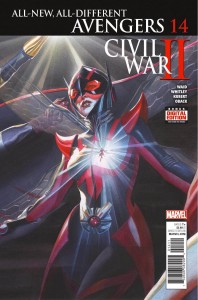 Hank Pym’s daughter from his first marriage to a Russian scientist, as she bonds with stepmom Janet Van Dyne, shows off her science chops, worries about all the American heroes fighting one another (Janet’s explanation is, basically, that they do stupid crap like this all the time; don’t worry about it, because eventually it’ll get better), and generally shows off her skills in preparation for the launch of her own comic early next year (written by Jeremy Whitley, which is why he’s co-writing this issue with Waid). Adam Kubert, like Mike Deodato, is a super-solid artist who can make anything look good, from the conversations to the small-scale fighting to the big explosions, so he’s a perfect choice for a stand-alone establish-the-character issue like this one.
Hank Pym’s daughter from his first marriage to a Russian scientist, as she bonds with stepmom Janet Van Dyne, shows off her science chops, worries about all the American heroes fighting one another (Janet’s explanation is, basically, that they do stupid crap like this all the time; don’t worry about it, because eventually it’ll get better), and generally shows off her skills in preparation for the launch of her own comic early next year (written by Jeremy Whitley, which is why he’s co-writing this issue with Waid). Adam Kubert, like Mike Deodato, is a super-solid artist who can make anything look good, from the conversations to the small-scale fighting to the big explosions, so he’s a perfect choice for a stand-alone establish-the-character issue like this one.
 Supergirl #1 — Writer: Steve Orlando; Art: Brian Ching; Colors: Michael Atiyeh
Supergirl #1 — Writer: Steve Orlando; Art: Brian Ching; Colors: Michael Atiyeh
Cyborg: Rebirth #1 (of 1) — Writer: John Semper Jr.; Pencils: Paul Pelletier; Inks: Sandra Hope and Tony Kordos; Colors: Guy Major
Ever After #1 — Writers: Dave Justus and Matthew Sturges; Art: Travis Moore; Colors: Michael Wiggam
A trio of DC first issues, two of them part of its continuing “Rebirth” rollout. Supergirl continues from its one-shot intro a few weeks ago, with a recently-arrived-on-Earth Kara dealing with angst about her vanished homeworld, a secret identity as a high-school student, her job helping the government agency that monitors superhuman threats, and a last-page villain reveal who will be familiar to  readers of the early-’90s “Death of Superman” aftermath (with the Eradicator as the bad guy over in Superman, and the protagonist here, there’s clearly some nostalgia for those now-over-twenty-year-old comics…). The art is fine, if a little sketchy (and Kara, especially in her costumed identity, is drawn with her eyes bigger than her mouth, making her look like a Margaret Keane painting), and both fans of the TV show and regular readers should find enough good things here to keep reading the series for a while, at least. Cyborg’s “Rebirth” one-shot is one of those “everything you knew about the origin was wrong” bits — which would be fine, except that the previous volume of the title, less than a year ago, did a similar retcon, so it elicits more a yawn than an “OMG.” Art and story are both just OK, but it would be nice to see a version of this title that just involved cool powers and capers by Vic, instead of tangled pasts and father issues. Ever After is a spinoff series from the long-running, recently-concluded Vertigo series Fables, with co-writer Matthew Sturges, who previously scripted the Jack of Fables companion
readers of the early-’90s “Death of Superman” aftermath (with the Eradicator as the bad guy over in Superman, and the protagonist here, there’s clearly some nostalgia for those now-over-twenty-year-old comics…). The art is fine, if a little sketchy (and Kara, especially in her costumed identity, is drawn with her eyes bigger than her mouth, making her look like a Margaret Keane painting), and both fans of the TV show and regular readers should find enough good things here to keep reading the series for a while, at least. Cyborg’s “Rebirth” one-shot is one of those “everything you knew about the origin was wrong” bits — which would be fine, except that the previous volume of the title, less than a year ago, did a similar retcon, so it elicits more a yawn than an “OMG.” Art and story are both just OK, but it would be nice to see a version of this title that just involved cool powers and capers by Vic, instead of tangled pasts and father issues. Ever After is a spinoff series from the long-running, recently-concluded Vertigo series Fables, with co-writer Matthew Sturges, who previously scripted the Jack of Fables companion 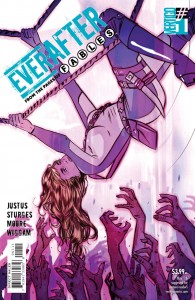 book, adding some authority and familiarity with the characters. The hook involves some of the fairy-tale creatures who haven’t left Earth for their homelands — Hansel (of … and Gretel), Connor Wolf (the teenage son of Bigby Wolf and Snow White), Little Bo Peep, Peter Piper and others — as part of a black-ops spy organization that fights magical threats — wild magic, pre-teen sorceresses, the occasional zombie infestation, etc. Moore has a mater-of-fact style that’s flexible enough to work with the various people, plus all the mystical creatures (and quite a bit of gore), and this first issue hits the ground running, with lots of action and colorful characters and double-crosses, so fans of the original Fables run, as well as new readers, should be intrigued enough to come back for more.
book, adding some authority and familiarity with the characters. The hook involves some of the fairy-tale creatures who haven’t left Earth for their homelands — Hansel (of … and Gretel), Connor Wolf (the teenage son of Bigby Wolf and Snow White), Little Bo Peep, Peter Piper and others — as part of a black-ops spy organization that fights magical threats — wild magic, pre-teen sorceresses, the occasional zombie infestation, etc. Moore has a mater-of-fact style that’s flexible enough to work with the various people, plus all the mystical creatures (and quite a bit of gore), and this first issue hits the ground running, with lots of action and colorful characters and double-crosses, so fans of the original Fables run, as well as new readers, should be intrigued enough to come back for more.
 Superman #6 — Writer: Peter J. Tomasi; Pencils: Patrick Gleason; Inks: Mick Gray; Colors: John Kalisz
Superman #6 — Writer: Peter J. Tomasi; Pencils: Patrick Gleason; Inks: Mick Gray; Colors: John Kalisz
Batman #6 — Writer: Tom King; Pencils: Ivan Reis; Inks: Joe Prado, Oclair Albert and Scott Hanna; Colors: Marcelo Maiolo
Justice League #4 — Writer: Bryan Hitch; Pencils: Jesus Merino; Inks: Andy Owens and Jesus Merino; Colors: Tomeo Morey
The Big Two DC heroes both reach the end of their first arcs this week. Superman‘s issues form the clearest stand-along story: this first sequence has introduced the older, married Superman to the world, and gotten his young super-son Jon involved in a fight with the insane Kryptonian Eradicator; this episode ends it on just the right note, as a beginning instead of an ending. Gleason, on the art, offers a noble Superman and likable versions of Krypto, Lois and Jon; like Brian Ching on Supergirl, he draws Jon’s  eyes bigger than they need to be, but it’s less annoying on a pre-teen, and there’s a page where Jon meets the other two members of the Trinity where, just by their expressions, he’s able to convey Wonder Woman’s open, welcoming smile and Batman’s disapproving scowl just right. Speaking of the Caped Crusader, Batman‘s own comic offers an epilogue to the story in the first five issues, and sees Gotham Girl mourning the death of her partner as Batman, who knows something about the loss of loved ones, tries to comfort her in an affecting, surprisingly quiet climax. Writer Tom King crafts an effective mix of continuity callbacks (two obscure Gotham villains, Colonel Blimp and Captain Stingaree, show up), action and pathos, while Ivan Reis’s detailed, well-composed pages (including a couple of very good-looking splashes) give the city and its inhabitants their requisite Gothic menace and charm. The ending isn’t as definite as Superman‘s, being more of more of an opening into the next arc, as the trail of the mastermind behind all the previous destruction leads out of the country, and Batman needs the help of a certain Amanda Waller to follow it — but her connection to a
eyes bigger than they need to be, but it’s less annoying on a pre-teen, and there’s a page where Jon meets the other two members of the Trinity where, just by their expressions, he’s able to convey Wonder Woman’s open, welcoming smile and Batman’s disapproving scowl just right. Speaking of the Caped Crusader, Batman‘s own comic offers an epilogue to the story in the first five issues, and sees Gotham Girl mourning the death of her partner as Batman, who knows something about the loss of loved ones, tries to comfort her in an affecting, surprisingly quiet climax. Writer Tom King crafts an effective mix of continuity callbacks (two obscure Gotham villains, Colonel Blimp and Captain Stingaree, show up), action and pathos, while Ivan Reis’s detailed, well-composed pages (including a couple of very good-looking splashes) give the city and its inhabitants their requisite Gothic menace and charm. The ending isn’t as definite as Superman‘s, being more of more of an opening into the next arc, as the trail of the mastermind behind all the previous destruction leads out of the country, and Batman needs the help of a certain Amanda Waller to follow it — but her connection to a 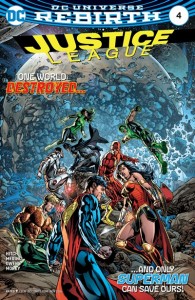 squad of recent movie characters should bring readers back, too. Justice League, on its fourth issue, is continuing one of those big galactic-level, Earth-threatening confrontations for the team; Hitch makes sure each of the JLers — Batman, Superman, Wonder Woman, Flash, the Lanterns, Cyborg and even Aquaman — get some screentime, and while it’s a basic plot it benefits from watching each of those icons strut his, or her, stuff, and use teamwork to… well, not defeat the menace yet, because the story’s got two issues to go, but at least keep the Earth from dying for now. Watching all those heroes work together, and separately, is the whole point of a book like Justice League, and Merino does his part by using standard-but-nice-looking superhero poses and dramatic layouts to make all the characters and aliens and moving parts clear.
squad of recent movie characters should bring readers back, too. Justice League, on its fourth issue, is continuing one of those big galactic-level, Earth-threatening confrontations for the team; Hitch makes sure each of the JLers — Batman, Superman, Wonder Woman, Flash, the Lanterns, Cyborg and even Aquaman — get some screentime, and while it’s a basic plot it benefits from watching each of those icons strut his, or her, stuff, and use teamwork to… well, not defeat the menace yet, because the story’s got two issues to go, but at least keep the Earth from dying for now. Watching all those heroes work together, and separately, is the whole point of a book like Justice League, and Merino does his part by using standard-but-nice-looking superhero poses and dramatic layouts to make all the characters and aliens and moving parts clear.
 Alters #1 — Writer: Paul Jenkins; Art: Leila Leiz; Colors: Tamra Bonvillain
Alters #1 — Writer: Paul Jenkins; Art: Leila Leiz; Colors: Tamra Bonvillain
Eclipse #1 — Writer: Zack Kaplan; Art: Giovanni Timpano; Colors: Betsy Gonia
Glitterbomb #1 — Writer: Jim Zub; Art: Djibril Morissette-Phan; Colors: K. Michael Russell
Skybourne #1 (of 5) — Writer/Artist: Frank Cho; Colors: Marcio Menyz
Night’s Dominion #1 — Creator: Ted Naifeh
Lots of indy first issues this week — Alters is set on a version of our Earth where some 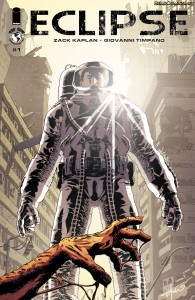 people have started to exhibit super-powers (they’re “altered,” hence the book’s title), and have quickly divided into groups of good guys and bad guys, who fight over the new recruits; one particular teen who’s developed major “quantum abilities” is the focus character. There’s a twist about ten pages in that makes the book particularly trendy (and a little controversial, I’d guess, in some circles), that’s a clever echo of the Heisenbergian dual nature of quantum mechanics; that helps to mask the comic’s essentially-standard world-building and super-powered fighting. Jenkins is an old pro at this sort of storytelling, and that art is OK — a little above average, and better in the big splash scenes — so this is a book worth watching, at least so far. Eclipse is another Image science-fiction book (imaginative writers and artists love the genre, and, thanks to the company’s
people have started to exhibit super-powers (they’re “altered,” hence the book’s title), and have quickly divided into groups of good guys and bad guys, who fight over the new recruits; one particular teen who’s developed major “quantum abilities” is the focus character. There’s a twist about ten pages in that makes the book particularly trendy (and a little controversial, I’d guess, in some circles), that’s a clever echo of the Heisenbergian dual nature of quantum mechanics; that helps to mask the comic’s essentially-standard world-building and super-powered fighting. Jenkins is an old pro at this sort of storytelling, and that art is OK — a little above average, and better in the big splash scenes — so this is a book worth watching, at least so far. Eclipse is another Image science-fiction book (imaginative writers and artists love the genre, and, thanks to the company’s 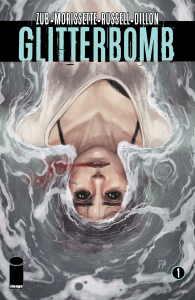 creator-friendly business model, can retain all the rights to their comics; if you think that isn’t important, talk to Robert Kirkman…). In this series, there was a huge solar flare ten years ago that killed a couple of billion people and altered the environment so that, now, exposure to direct sunlight will melt your flesh off and kill you; people live underground and come out to the surface at night, and God help them if they get stuck in the open after sunrise. Now, a serial killer is leaving people outside to die and writing taunting religious quotations in their blood, and so the comic’s a future-police procedural as the lone-wolf good guy gets recruited by the authorities to catch him. Not bad if you’re an sf or crime-thriller fan; if you like similar cop/future mashups like, say, The Fuse, this will be right up your alley. Glitterbomb is a horror book, in the sub-genre of oppressed-women-with-monstrous-powers (see, most recently, Insexts); an aspiring young-mom actress who keep failing auditions tries to drown herself, but ends up
creator-friendly business model, can retain all the rights to their comics; if you think that isn’t important, talk to Robert Kirkman…). In this series, there was a huge solar flare ten years ago that killed a couple of billion people and altered the environment so that, now, exposure to direct sunlight will melt your flesh off and kill you; people live underground and come out to the surface at night, and God help them if they get stuck in the open after sunrise. Now, a serial killer is leaving people outside to die and writing taunting religious quotations in their blood, and so the comic’s a future-police procedural as the lone-wolf good guy gets recruited by the authorities to catch him. Not bad if you’re an sf or crime-thriller fan; if you like similar cop/future mashups like, say, The Fuse, this will be right up your alley. Glitterbomb is a horror book, in the sub-genre of oppressed-women-with-monstrous-powers (see, most recently, Insexts); an aspiring young-mom actress who keep failing auditions tries to drown herself, but ends up 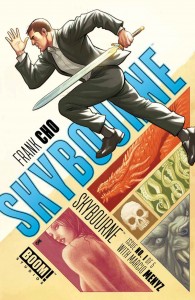 possessed by… something, which then visits Lovecraftian vengeance upon her sexist tormentors. The art reminds me a little of Sean Murphy (Joe the Barbarian; Punk Rock Jesus), although without quite his level of detail or facility with faces yet; it’s decent at the horror set-pieces, and there are enough shocks and character bits to make it all work. Skybourne is a Frank Cho creation about three immortals (the “children of Lazarus,” because apparently after Jesus resurrects you your kids have super-powers) who, in the present day, are chasing after the sword Excalibur before Merlin can get his hands on it and wreak havok. Typically lush Cho art, with the female of the group as the main character in this first issue (Cho, like Adam Hughes or Kevin Maguire, is particularly known for his facility for drawing good-looking women, even if they all end up looking like Brandy, from his comic strip Liberty Meadows), although there’s a Daredevil #181 denouement
possessed by… something, which then visits Lovecraftian vengeance upon her sexist tormentors. The art reminds me a little of Sean Murphy (Joe the Barbarian; Punk Rock Jesus), although without quite his level of detail or facility with faces yet; it’s decent at the horror set-pieces, and there are enough shocks and character bits to make it all work. Skybourne is a Frank Cho creation about three immortals (the “children of Lazarus,” because apparently after Jesus resurrects you your kids have super-powers) who, in the present day, are chasing after the sword Excalibur before Merlin can get his hands on it and wreak havok. Typically lush Cho art, with the female of the group as the main character in this first issue (Cho, like Adam Hughes or Kevin Maguire, is particularly known for his facility for drawing good-looking women, even if they all end up looking like Brandy, from his comic strip Liberty Meadows), although there’s a Daredevil #181 denouement  that suggests one of the other siblings might be the book’s true hero. If you prefer your comics with lots of cinematic spy-thriller action, here you go. Night’s Dominion is by Ted Naifeh, best known for his Courtney Crumrin, a quirky, Gothic little fantasy series about a girl witch. This new offering is fantasy, too, solidly in the D&D vein. Maybe too solidly; this first issue gathers together a thief, a mage, a cleric, a bard and an assassin in order to rob a tower of its treasure, and reads exactly like the beginning of a well-run gaming-table campaign. It gets by on Naifeh’s shadowy art, dripping with atmosphere, and on some deeper-than-usual characterization; if you like this kind of thing, it’s a high-end version of it.
that suggests one of the other siblings might be the book’s true hero. If you prefer your comics with lots of cinematic spy-thriller action, here you go. Night’s Dominion is by Ted Naifeh, best known for his Courtney Crumrin, a quirky, Gothic little fantasy series about a girl witch. This new offering is fantasy, too, solidly in the D&D vein. Maybe too solidly; this first issue gathers together a thief, a mage, a cleric, a bard and an assassin in order to rob a tower of its treasure, and reads exactly like the beginning of a well-run gaming-table campaign. It gets by on Naifeh’s shadowy art, dripping with atmosphere, and on some deeper-than-usual characterization; if you like this kind of thing, it’s a high-end version of it.
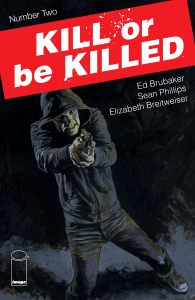 Kill or be Killed #2 — Writer: Ed Brubaker; Art: Sean Phillips; Colors: Elizabeth Breitweiser
Kill or be Killed #2 — Writer: Ed Brubaker; Art: Sean Phillips; Colors: Elizabeth Breitweiser
Paper Girls #9 — Writer: Brian K. Vaughan; Art: Cliff Chiang; Colors: Matt Wilson
The Shadow: The Death of Margo Lane #4 (of 5) — Writer/Artist: Matt Wagner; Colors: Brennan Wagner
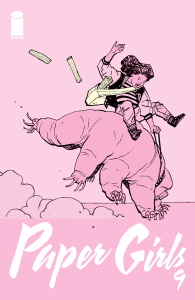 My other indy books: Kill or be Killed is a Brubaker/Phillips supernatural crime thriller whose suicidal protagonist gets cursed by a demon: he has to kill one “bad” guy every month, or he goes to hell himself. The first issue set up that premise, and this second goes more for gritty crime drama, as the demon isn’t seen (was he a delusion, or real?) but our hero still goes about the grim business of figuring out who deserves to die, and how he’s going to do it. I buy this book because Brubaker/Phillips do this stuff better than anybody.
My other indy books: Kill or be Killed is a Brubaker/Phillips supernatural crime thriller whose suicidal protagonist gets cursed by a demon: he has to kill one “bad” guy every month, or he goes to hell himself. The first issue set up that premise, and this second goes more for gritty crime drama, as the demon isn’t seen (was he a delusion, or real?) but our hero still goes about the grim business of figuring out who deserves to die, and how he’s going to do it. I buy this book because Brubaker/Phillips do this stuff better than anybody. 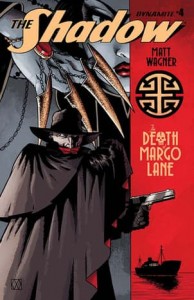 Paper Girls, on the other hand, I keep thinking about dropping — it’s got a tangled time-travel plot that’s both complicated and annoying, because we can’t tell which side, if any, is telling the truth — but then every issue has a couple of great-looking pages by Chiang (a centerfold shot of a blimp; the way his characters’ eyes turn into cute little dots in long shots), or a line of dialogue that reveals character, or an unexpected plot twist, or a small, perfect bit of human drama, and I stay hooked. The Shadow offers pure Matt Wagner, alljoyfully-pulpy dialogue and art and filled-in shadowy inking, not to mention thirty years’ worth of storytelling chops: some comics choices are obvious.
Paper Girls, on the other hand, I keep thinking about dropping — it’s got a tangled time-travel plot that’s both complicated and annoying, because we can’t tell which side, if any, is telling the truth — but then every issue has a couple of great-looking pages by Chiang (a centerfold shot of a blimp; the way his characters’ eyes turn into cute little dots in long shots), or a line of dialogue that reveals character, or an unexpected plot twist, or a small, perfect bit of human drama, and I stay hooked. The Shadow offers pure Matt Wagner, alljoyfully-pulpy dialogue and art and filled-in shadowy inking, not to mention thirty years’ worth of storytelling chops: some comics choices are obvious.


